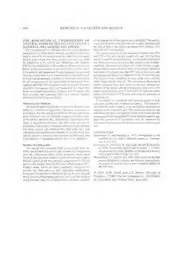
The biochemical composition of natural food of Penaeus esculentus Haswell (Penaeidae: Decapoda) PDF
Preview The biochemical composition of natural food of Penaeus esculentus Haswell (Penaeidae: Decapoda)
448 MEMOIRS.OF THE QUEENSLAND MUSEUM THE BIOCHEMICAL COMPOSITION OF of the natural diet of the prawns was calculated, The profile. NATURAL FOOD OF PENAEUS ESCULENTUS expressed in terms of the ash-free dry weight, indicated that HASWELL (PENAEIDAE; DECAPODA) the natural diet of the prawns contained 66% protein, 13% The development of artificial diets for penacid prawn lipid and 21% carbohydrate. aquacullure has been almost entirely an envpirical process. The protein contents of the commercial feeds were 51% largely driven by the need to provide a diet |hat gives good and 77% of the ash tree dry weight, 8% and 16% for lipid growth al minimum cos!. Some of the early work was done and 41% and 8% for carbohydrate. Amino acid composition by Kanazawa et al. (1970) and Deshimam and Shigeno was fairly uniform in all species and similar to the commer- (1972) who formulated artificial diets for Penaeus japonicus cial feeds, Cholesterol was above 4% of ash-tree dry weight; based on the composition of the short-necked clam. Tapes phospholipids ranged from 22-80% of total lipid. Saturated (=Venerupis) philippinarum. Penaeus japonicus grows well fatty acids were mostly less than 45% of total fatty acids and ona diet of this clam, but it is not normally eaten in the wild, polyunsaturated fatty acids ranged trom 24-56% of the lotal, A more logical approach would be to formulate a diet based The Zostera seeds contained no fatty acids with a carbon on the composition of the natural food of the prawn, Was- chain length greater than 18, The commercial feeds had a senberg and Hill (1987) studied the diet of juvenile Penaeus similar saturated fatty acid profile to the prey animals but esculentus in seagrass beds and found that ihe main prey differed in the mono- and polyunsaturated fatty acids with items were small pastropods, bivalves and Crus{acea. We highér concentrations of CL8:1w9 and C18:2w6 and with a have analysed and compared these prey animals together lower concentralion of C20:4wé6, reflecting the presence of with lwo commercial prawn feeds. vegetable oils. P, esculentus is a relatively slow growing prawn in both Materials and Methods aquarium sysiems and in aquaculture ponds. The reason for The most abundant known prey of juvenile Penaeus eseu- this could be some response la environmental condilions in len(us (i.e. 3 species of gastropod, 2 bivalves, 4 crustacea. a caplivily or an unsuitable diet. The difterences between the polychaete, and ripe and green seeds of Zostera capricorm) proximate and fatty acid profiles of the natural diet and the were collected from an intertidal seagrass (Zostera capri- commercial feeds formulated for other penacid species sug- corni) bed in Moreton Bay, Queensland. Collections were gesls thal growth of P, esculentus may be improved by made in September, February and May when juvemile P. altering the formulation of the feed towards thaoft th e natural eéscuilentus were present, Proximate analyses (water content. diet. ash, lipid, protein and carbohydrate), lipid class, fatty acid and amino acid analyses were carried out on each oft he prey Literature Cited species and on 2 commercially produced prawn feeds, one Deshimaru, QO. and Shigeno, K. 1972. Introduction to the formulated for P. monadon and the other for P. japonicus. artificial diet for prawn, Penaeus japonicus. Aquacul- ture 1: 115-133. Results and Discussion Kanazawa, A., Shimaya, N., Kawasaki, M. and Kashiwada, The natural diet contained high levels of ash from the K, 1970, Nutritional requirements of prawn 4 |: Feed- shells and exoskeletons of the prey animals so comparisons ing on an artificial diet, Bulletin of the Japanese Society with the commercial] diets, which contained much lower for Scientific Fisheries 36; 211-215. levels of ash, have been made using the ash-free dry weights. Wassenberg, T.J, and Hill, B.J. 1987. Natural diet of the liger Protein content of the prey animals ranged from 52-76% of prawns Penaeus esculentus and Penaeus semisulcatus. ash-free dry weight, lipid 10-20% and carbohydrate 6-21 %. Australian Journal of Marine and Freshwater Research Zostera seeds. which are ealen seasonally, contained 9% 38: 169-182. protein, 4% lipid and over 60% digestible carbohydrate. W. Dall, D.M. Smith, and L.E. Moore, Division of Using the % numerical composition dita of the prey animals of the prawns (Wassenberg and Hill, 1987) and the weights Fisheries, CSIRO Marine Laboratories, 233 Middle and proximate analyses of representative animals, a profile St, Cleveland, Queensland 4163, Australia,
